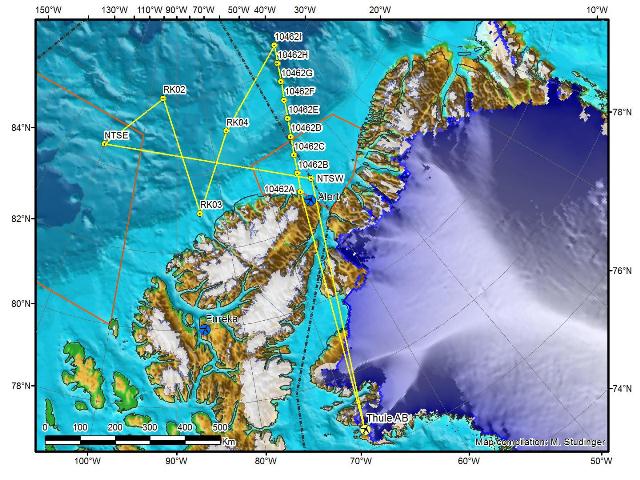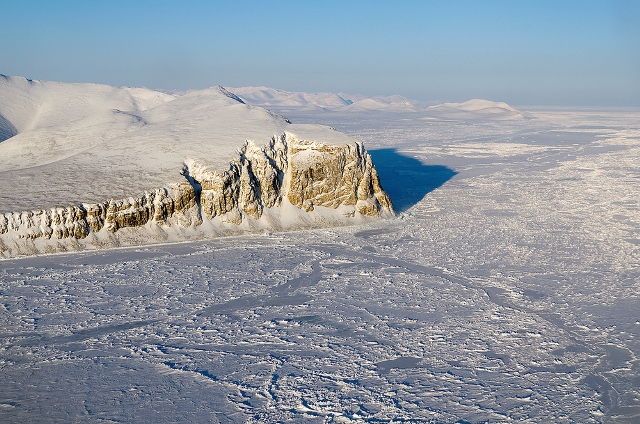From Michael (NASA), the Arctic, 29 March
Today marks the centennial of Sir Robert Falcon’s death on the Ross Ice Shelf on March 29, 1912. There are many commemorative events taking place around the world today to remember the scientific accomplishments of the Terra Nova Expedition. The most prominent of all events is a National Service of Commemoration for Captain Scott and the Pole Party at St. Paul’s Cathedral in London, with our own Seelye Martin participating as a guest of honor. In 2008, I had the privilege to visit Captain Scott’s historic Terra Nova Hut on Cape Evans in Antarctica, and the geographic South Pole, where the National Science Foundation has installed a sign with Scott’s famous quote. It took my breath away.
One hundred years later we launch two aircraft from different locations and meet up over the Arctic Ocean on a track that has been flown shortly before by a spacecraft more than 600 km above us.
A lot has changed to say the least, but nevertheless operating in remote polar regions remains a challenge even today, with the safety and success depending on extremely experienced and skilled members of the aircrew and instrument teams that excel in meeting this challenge every day. Today’s polar research is driven by a spirit of international collaboration and today’s flight is a fine example of what can be accomplished when many nations and organizations team up instead of competing with each other. Recognizing the enormous accomplishments of the early polar explorers we dedicate today’s mission to the members of the Terra Nova Expedition who died in Antarctica 100 years ago.
The first part of today’s mission was a joint survey with the European Space Agency’s CryoVEx campaign. The plan was to fly three aircraft and CryoSat-2 within hours on the same satellite orbit. In addition to the P-3 (N426NA), the Technical University of Denmark (DTU Space) has chartered a DHC-6-300 Twin Otter (TF-POF) from Norlandair and has installed a laser scanner and ASIRAS, which is the airborne version of SIRAL, the radar that flies on the CryoSat-2 spacecraft. We had also planned to have a Basler BT-67 (DC-3) aircraft, ‘Polar 5’ (C-GAWI) from the Alfred Wegener Institute in Germany, participate in the joint flight. The Polar 5 is equipped with an EM-31 bird for measuring sea ice thickness, an airborne laser scanner, and nadir looking video and camera systems. Unfortunately, there was a technical issue with the EM-31 bird that could not be resolved in time for the flight and the Polar 5 did not participate on today’s CryoVEx flight.
The choreography of events we had developed worked out perfectly. We had excellent weather in the survey area, which was an incredible help. We only have two orbits per day that are inside the temporary SAR mode mask of CryoSat-2 north of Alert (see map) and selected the early morning orbit that was flown by the spacecraft at 11:31 Zulu. The P-3 took off from Thule as soon as the airfield opened at 11:00 Z. At 12:12 Z we were close to Alert and heard on the radio that the Norlandair Twin Otter was taxiing. N426NA reached the start of the survey line at the coast of Ellesmere Island at 12:18 Z with TF-POF close behind us. The timing worked out perfectly – a job well done by everyone involved. At 13:16 Z we reached the end of the CryoSat survey line and turned towards waypoint RK04 of the ZigZag West mission plan. At 17:05 Z we reached the end of the survey line at waypoint NTSW and started climbing for the transit back to Thule.
It was a perfect day.
More pictures are here:











Discussion: no comments